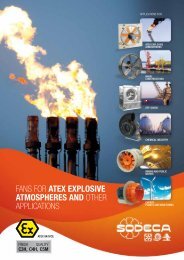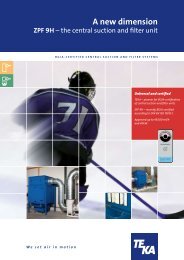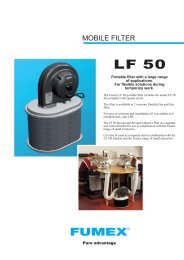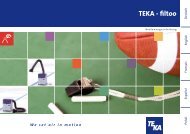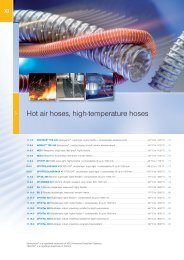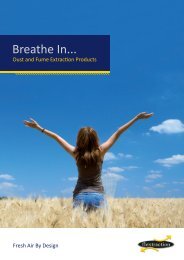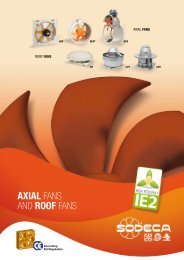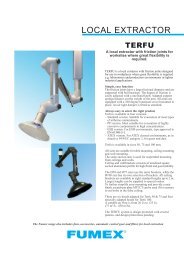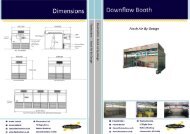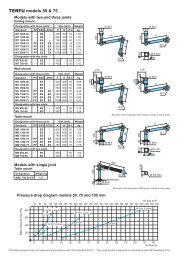Fixed Filter Unit - Filtercube - Teka Manual - Flextraction
Fixed Filter Unit - Filtercube - Teka Manual - Flextraction
Fixed Filter Unit - Filtercube - Teka Manual - Flextraction
You also want an ePaper? Increase the reach of your titles
YUMPU automatically turns print PDFs into web optimized ePapers that Google loves.
Operating InstructionsTEKA – FILTERCUBE 4TEKA Absaug- und EntsorgungstechnologieGmbHIndustriestraße 13 D-46342 VelenPostfach 1137 D-46334 VelenTel.: +49 (0) 2863 9282-0Fax: +49 (0) 2863 9282-72E-Mail: sales@tekanet.dewww.tekanet.de
Contents1 Drawing / Description of components 32 Introduction 53 Function of the TEKA – FILTERCUBE 4 54 Safety instructions 65 Transport 76 Installation 77 Initial operation 87.1 Mounting of extraction and suction elements 87.2 Electrical connection 87.3 Pre-coating of the filter cartridges 97.4 Connection of the compressed air supply 98 Explanation of the Controls 109 Test run 1010 Set extraction elements 1011 Other extraction elements 1112 Operation 1113 Maintenance and service 1113.1 Cleaning of the filter cartridges 1213.2 Compressed air supply 1213.3 Emptying of the dust collecting tank 1313.4 Discharging the condensation 1313.5 Replacement of the filter cartridges 1414 Error search 1514.1 No function 1514.2 Suction performance too low 1614.3 Insufficient extraction 1615 Disassembly / disposal 1616 Technical Data 1717 List of spare parts 1818 Declaration of conformity TEKA-<strong>Filter</strong>cube 4 19BA_<strong>Filter</strong>cube4_091217_GB-neu.doc 2 17.12.2009
<strong>Filter</strong>cube 4HPos.1aPos.1bPos.1cPos.1dPos.1ePos.1fPos.2Pos.3Pos.4Pos.5Pos.6Pos.7Pos.8Joggle buttonStatus indicator, greenWarning indicator, redDisplay<strong>Unit</strong> switch (up to and including aventilator output of 4.0kW)Stroboscope flashCleaning housingService door for pneumatics<strong>Filter</strong> housingService door for cartridgesDust collecting housingService door for tankChutePos.9Pos.10Pos.11Pos.12Pos.13Pos.14Pos.15Pos.16Pos.17Pos.18Pos.19Pos.20Pos.21TankIntake stubExhaust stubToggle fastener<strong>Filter</strong> cartridgeCartridge bracketLocking screw for filter cartridgeCompressed air tankCompressed air connectionDischarge cock for condensationHandleCoverIntermediate plate with cartridge guidanceBA_<strong>Filter</strong>cube4_091217_GB-neu.doc 4 17.12.2009
2 IntroductionIn the last few years extractor units have gained in importance. The filtering of extracted pollutants andthe recycling of filtered air to the working area.This is a surely a sign that the environmental consciousness of every one of us has altered very stronglyin favour of our environment. We have known for a long time that contaminants arise during production,for example and that the type of contaminant depends on the particular industrial process used. Onecan basically distinguish between gases and fumes (smoke). Fumes could also really be described asdust. If you examine this dust under a microscope, you will find that they consist of very fine particles,often with a size of 0.001 mm or smaller, that can enter the lungs.The classical method of trying to improve the working conditions of polluted workplaces is generalventilation. This involves changing the entire air in the production hall many times. However, thismethod has only a minimal effect on the concentration of the contaminants in the immediate areaaround the worker, i.e. in the air he breathes.The same applies to so-called overhead extractor systems, i.e. large extractor heads mounted abovethe workspace. With this very unsatisfactory method the contaminants first travel across the breathingspace of the worker upwards before they are collected and taken out. This is surely not the point of theexercise. A much more effective method than overhead/wide-area extraction is the removal of pollutantsdirectly at their source, with localised extraction. Both the initial investments and the running costs areconsiderably lower with localised extraction.Localised extraction works best, however, when the work process itself is operating optimally, and, ofcourse, the correct measures must be in place regarding the environment and the prevention ofaccidents at work. In a time of increasing sensitivity and tougher legislation, the task therefore lies inmaking an early assessment of the potential hazards for the workplace and the environment, andreducing them as appropriate.3 Function of the TEKA – FILTERCUBE 4The filter unit TEKA - FILTERCUBE 4 is primarily used for extracting dust and fumes. For this purpose,the unit must be equipped with the corresponding application-specific fittings.The polluted air is extracted via a specific extraction fitting and gets through the pipeline into the filterunit. The rough dust particles are deflected here on the integrated perforated plate. The particle-shapedpollutants are discharged on the surface of the following filter cartridges. The cleaned air is sucked bythe ventilator and discharged outside or recycled into the work room via a corresponding exhaust air line.As soon as the resistance of the filter cartridge has achieved a maximum value through the dischargeddust particles or after a corresponding set idletime, the filters are cleaned automatically.Caution:The filter cake is removed through the installed pneumatic cleaning which evenly distributes thecompressed air over the filter surface. (see chapter 13.1 Cleaning of the filter cartridges)The removed dust is gathered in the tank from which it can be removed. (see chapter 13.3 Emptying ofdust collecting tank)BA_<strong>Filter</strong>cube4_091217_GB-neu.doc 5 17.12.2009
4 Safety instructionsThe following basic safety measures must be observed to prevent electric shocks, injury or fire whenusing electrical devices:• Read and follow these instructions before you use the unit!• Store the operating and service instructions in a secure place!• Limits of application:welding fumes containing oil mist, aluminium dust, grinding dust, metallic dusts, gases, water,not for EX-zones, etc. (If there is any doubt about the application, please contact themanufacturer!)• Do not employ the unit for the extraction of easily combustible or explosive gases and/ordust mixtures!• Do not employ the unit in explosive zones, e.g. zone 0, zone 1, zone 2, zone 20, zone 21,zone 22!• Do not employ the unit for sucking burning or glowing materials, e.g. cigarettes, matches,metallic types of dust and/or splinters, paper, cleaning cloths, oils or oil mist, greases,separating agents (e.g. silicon spray), cleaning agents, etc.!• Do not use the unit for the extraction of aggressive media!• Do not use the unit for sucking liquids of any kind!• Do not use the unit for extraction of any organic matters without the written permission of themanufacturer!• Protect the connecting lead from heat, moisture, oils and sharp edges!• Pay attention to the correct voltage!(Observe the information on the nameplate!)• Only use original TEKA spare parts!• Do not operate the unit without a filter cartridge installed!• Disconnect the filter unit from the mains supply before opening the unit and secure against itbeing switched on again!• The compressed air tank is to be emptied before carrying out all maintenance and repairwork.• The exhaust outlet must not be obstructed or blocked in any way!• Always take care that the unit stands secured and that the caster brakes are set!• Disconnect from the mains supply when cleaning or servicing the unit, when exchanging anyparts or when changing machine settings for a different function and secure it against beingswitched on again!• The filter cartridges cannot be regenerated for repeated use!• The filters must be disposed of according to relevant legislation and directives!• At regular intervals inspect the mains supply lead for signs of damage!• The unit must not be used if there is any damage or irregularity to the mains supply lead!• Use only dry and oil-free compressed air with pressure ratings from minimum 1 bar to 6 barmaximum.BA_<strong>Filter</strong>cube4_091217_GB-neu.doc 6 17.12.2009
• Do not use the filter unit if any one or more components of the system are defective, missingor damaged. In any one of these instances please contact the TEKA Service Department:Phone no.: +49 (0) 28 63 / 92 82 – 0• When extracting carcinogenic welding fumes as from the processing of nickel or chromealloys, the requirements of the directives on clean air of the German TRGS 560 “Return ofprocess air when working with carcinogenic media”must be observed!• Further information regarding the TRGS 560 can be obtained from the “BIA -Berufsgenossenschaftliches Institut für Arbeitssicherheit”(Institute for work safety of theemployers’liability insurances) at D-53754 Sankt Augustin, Germany.• Additional authorized protective equipment is to be used when working on the unit orcollecting such as e.g. respiratory mask, eye protectors, noise protection.We recommend using a respiratory mask according to DIN EN 141/143 - Protection class P3.5 Transport• Transport the machine on a pallet intended for this purpose, secure against falling over andshifting.• Lift the machine and transport with a hand lift truck or fork lift truck.• Lifting trucks or fork lift trucks must have a minimum load bearing capacity of 2000 kg.• Do not stand below and/r besides the loan when lifting and putting down.• Remove all persons who are standing around from the danger zone.• Observe the manufacturer’s instructions or contact the manufacturer.6 Installation• Wear safety shoes with steel caps!• Remove all persons who are not required for installation from the danger zone.• Stipulate instructions for surface and load-bearing capacity.• The machine must be easily accessible from all sides.• Observe the manufacturer’s instructions or contact the manufacturer.BA_<strong>Filter</strong>cube4_091217_GB-neu.doc 7 17.12.2009
7 Initial operation• Observe the information on the nameplate.• The machine may only be connected by authorized and skilled electricians.• Remove all persons who are not required for connecting the power supply from the dangerzone.• The extraction elements and if applicable other accessories, must be mounted or installed tothe unit prior to initial operation.• The filter cartridges must be pre-coated before initial operation if these have not alreadybeen pre-coated by the plant. (If there is any doubt about the application, please contact themanufacturer!)• The machine must be easily accessible from all sides.• Observe the manufacturer’s instructions or contact the manufacturer.7.1 Mounting of extraction and suction elements• The assembly may only be carried out by qualified staff.• The extraction element is to be fastened to the intake stub by means of a suction pipe orsuction hose (Pos.10).• The exhaust air element is to be fastened to the exhaust outlet (Pos. 11) using a suctionpipeline.• Remove all persons who are not required for assembling the extraction or exhaust elementfrom the danger zone.• Only use TEKA – extraction elements and TEKA – exhaust elements.• The machine must be easily accessible from all sides.• Observe the manufacturer’s instructions or contact the manufacturer.7.2 Electrical connection• Observe the information on the nameplate.• The machine may only be connected by authorized and skilled electricians.• Remove all persons who are not required for connecting the unit from the danger zone.• Connect the filter unit to the mains supply.• The machine must be easily accessible from all sides.• Observe the manufacturer’s instructions or contact the manufacturer.Caution:Work on the electrical components may only be carried out by authorized personnel!Observe the information on the nameplate!BA_<strong>Filter</strong>cube4_091217_GB-neu.doc 8 17.12.2009
7.3 Pre-coating of the filter cartridgesThe filter cartridges only have to be pre-coated if these have not already been pre-coated by the plant.(If there is any doubt about the application, please contact the manufacturer!)• Observe the information on the nameplate.• The pre-coating may only be carried out by qualified personnel.• Remove all persons who are not required for the pre-coating of the filter cartridges from thedanger zone.Caution:There must be no compressed air in the compressed air tank.• Start the system without the work process.• Apply the pre-coat (10g per square metre of filter surface area) over the extraction pointwhich is nearest to the filter system in the suction line.• Observe the manufacturer’s instructions or contact the manufacturer.7.4 Connection of the compressed air supply• External supply only using an authorized compressed air hose!• The assembly may only be carried out by qualified staff.• The compressed air may not be connected until the filter differential pressure value wasreached, which is set in the Pulsecontrol when cleaning begins (see separate operatinginstructions of the software).• Remove all persons who are not required for connecting the compressed air supply from thedanger zone.• The compressed air must be dry and oil-free.• Connect the compressed air hose by means of a quick coupling line to the end piece nozzle(Pos.17).• The supplied operating pressure must have a minimum 1 bar and a maximum 6 bar andmust be set dependent on the process.• The external compressed air supply must be designed to the extent that the compressed airtank reaches the operating pressure again within the valve idletime (see operatinginstructions of the Pulsecontrol – Software).• The machine must be easily accessible from all sides.• Observe the manufacturer’s instructions or contact the manufacturer.Caution:The compressed air tank must be emptied before carrying out all service and repair work and thefilter unit disconnected from the power supply and secured against being switched on again!In case of leakage to the pneumatic system, the filter unit must not be put into operation anymore.Without compressed air supply the filter cartridge gets dirty very fast and the device switches todisturbance (filter full)!BA_<strong>Filter</strong>cube4_091217_GB-neu.doc 9 17.12.2009
8 Explanation of the ControlsPos.1a You can operate the control system menu by turning or pressing the joggle button.Pos.1b The status control lamp illuminates for approximately seven (07) seconds when you switchon the control system and also when a low pressure (vacuum) builds up as a result of a flowto the filters.Pos.1c The warning lamp indicates whether the filters need to be changed.Pos.1d The display shows the status of the control system and any operating messages.Pos.1e The unit switch switches the machine on or off. The unit switch is installed up to andincluding a ventilator output of 4.0kW. From a ventilator output of 5.5kW the ventilator mustbe started via a separate control (e.g. star-delta connection).Pos.1f The Stroboscope flash indicates whether the filters need to be changed.9 Test run• All protective equipment has to be affixed before the trial run.• Observe the information on the nameplate.• The trial run of the machine may only be carried out by qualified personnel.• All persons who are not required for the trial run are removed from the danger zone.• The machine must be easily accessible from all side.• Observe the manufacturer’s instructions or contact the manufacturer.10 Set extraction elements• They must be positioned directly on or as close as possible to the point of production(localised extraction).• For the protection of the health the industrial safety act (ArbSchG) stipulates that thedangers involved with the work for the employees must be determined, assessed andcorresponding industrial safety measures be carried out.• If not otherwise possible use additionally authorized protective equipment for the user suchas e.g. respiratory mask, eye protectors, noise protection. We recommend using arespiratory mask according to DIN EN 141/143 - Protection class P3.• Remove all persons who are not required for the work which is to be directly carried out fromthe danger zone or if applicable additionally equip with protective equipment.• The machine must be easily accessible from all side.• Observe the manufacturer’s instructions or contact the manufacturer.BA_<strong>Filter</strong>cube4_091217_GB-neu.doc 10 17.12.2009
11 Other extraction elements• Observe the manufacturer’s instructions or obtain release of the manufacturer.• Consult application technicians.12 Operation• Observe the correct position of the extraction element and details on the nameplate.• Follow the manufacturer’s instructions.• Remove all persons who are not required for the work which is directly to be carried out fromthe danger zone or if applicable additionally equip with protective equipment.• If not otherwise possible use additionally authorized protective equipment for the user suchas e.g. respiratory mask, eye protectors, noise protection. We recommend using arespiratory mask according to DIN EN 141/143 - Protection class P3.• Caution: Only use original TEKA products!13 Maintenance and serviceThe accumulation of extracted particles on the filter cartridge will eventually lead to a reduction of thesuction / extraction performance.The level of saturation of the filter cartridge is monitored electronically. The filter cartridge is cleanedautomatically in order to retain the admissible suction performance of the unit. (see chapter 13.1Cleaning of the filter cartridges)The accumulated dust particles are blown off the filter by applying compressed air from the clean side.The released filter cake will drop into the dust collecting tank. (see chapter 13.3 Emptying of dustcollecting tank)The useful service life of the filter cartridge greatly depends on the operational environment. For thisreason, it cannot be predicted. Should after cleaning the filter cartridge the operating pressure of thefilter system no longer be reached, the red indicator lamps will illuminate (see separate operatinginstructions of the software) and the filter cartridge must be replaced. (see chapter 13.5 Replacementof the filter cartridges)Caution:Disconnect from the mains supply when cleaning or servicing the unit, when exchanging any parts orwhen changing machine settings for a different function and secure against being switched on again.The operation of the filter unit must be interrupted when changing the filter cartridge.The compressed air tank is to be emptied before carrying out all maintenance and repair work.Exchange of the filter cartridge and the disposal of the element may be executed only in amplyventilated environments and when using an appropriate protective respiratory mask!We recommend using: A respiratory mask according to DIN EN 141/143 - Protection class P3.The task of changing the filter elements should be executed by trained personnel only!BA_<strong>Filter</strong>cube4_091217_GB-neu.doc 11 17.12.2009
13.1 Cleaning of the filter cartridgesThe level of saturation of the filter cartridges is monitored electronically. The filter cartridge is cleanedautomatically in order to retain the admissible suction performance of the unit.The filter unit remains in operation status during the automatic cleaning.Should the cleaning process no longer manage to clean the filter cartridge at its operating pressurethen the filter cartridge must be replaced. (see chapter 13.5 Replacement of the filter cartridges)13.2 Compressed air supplySuitable compressed air supply must be proved to ensure the correct function of the suction unit.• The compressed air supply may only be checked by qualified personnel.• Remove all persons who are not required for the work which is directly to be carried out fromthe danger zone or if applicable additionally equip with protective equipment.• The compressed air must be dry and oil-free.• The resulting condensation in the compressed air tank (Pos.16) is to be emptied at regularintervals.• If an upstream water trap should be used (available as an option), this is also to becontrolled at regular intervals and emptied if necessary.• The pneumatic components are to be checked regularly for tightness.• The external compressed air must be supplied via an authorized compressed air hose.• The supplied operating pressure must be a minimum 1 bar and maximum 6 bar and must beset dependent on the process.• As buffer - reserve a compressed air tank is installed in the pneumatics housing. Contentsare sufficient for one cleaning-session.• The external compressed air supply must be designed to the extent that the compressed airtank reaches the operating pressure again within the valve ideltime (see separate operatinginstructions of the software).Caution:The compressed air tank is to be emptied before carrying out all maintenance and repair work.In case of leakage of the pneumatic system the suction unit must not be put into operation anymore.Without compressed air supply the filter cartridge gets dirty very fast, and the device switches todisturbance (filter full)!BA_<strong>Filter</strong>cube4_091217_GB-neu.doc 12 17.12.2009
13.3 Emptying of the dust collecting tankThe dust collecting tank must be emptied after a certain number of operating hours. This is determinedaccording to the incurred volume of dust, the dust collecting tank must however be emptied at leastonce a week. The dust collecting tank may be filled however to a maximum 25%! (If there is any doubtabout the application, please contact the manufacturer!)• The dust collecting tank may only be emptied by qualified personnel.• Remove all persons who are not required for the work which is to be directly carried out fromthe danger zone or if applicable additionally equip with protective equipment.• Disconnect the machine from the power supply and secure against being switched on again.• Empty the compressed air tank (Pos.16) by opening the ball valve (Pos.27).(Condensation can leak by opening the ball valve.)• Close the ball valve again (Pos.18) when the compressed air tank (Pos. 16) is completelyempty.• Suitable respiratory protection and eye protectors are to be worn when servicing the unit.We recommend using: A respiratory mask according to DIN EN 141/143 - Protection classP3.• Open the service door for tank (Pos.7).• Remove the dust collecting tank (Pos.9) from the dust collecting housing (Pos.6).• The collect dust must be stored properly in a suitable container and disposed of according topertinent regulations.• Push the dust collecting tank (Pos.9) into the dust collecting housing (Pos.6).• Hook in and close the clamping fasteners so that the tank (Pos.9) seals tightly under thechute (Pos.8) of the filter unit. (check the sealing under the chute (Pos.8) for damages and ifapplicable replace.)• Connect the control for the cleaning with the power supply.(Observe the information on the nameplate!)•Caution:We recommend using: A respiratory mask according to DIN EN 141/143 - Protection class P3.The work processes specified above may only be carried out by a correspondingly trained employee!The dust must be disposed of according to relevant legislation and directives!13.4 Discharging the condensationThe resulting condensation in the compressed air tank (Pos.16) is to be emptied at regular intervals, atleast however once a month.• The dust collecting tank may only be emptied by qualified personnel.• Remove all persons who are not required for the work which is to be directly carried out fromthe danger zone or if applicable additionally equip with protective equipment.• Disconnect the machine from the power supply and secure against being switched on again.• Disconnect the filter unit from the external compressed air supply.BA_<strong>Filter</strong>cube4_091217_GB-neu.doc 13 17.12.2009
• Open the discharge cock (Pos.18) and fill the condensation into a suitable container. (Byopening the discharge cock compressed air stored in the compressed air tank (Pos.16) willescape.)• Properly store the discharged condensation in a suitable container and dispose of accordingto the regulations.• Close the discharge cock (Pos.18).• Connect the compressed air tank at the external compressed air supply.• Connect the control for the cleaning with the power supply. (Observe the information on thenameplate!)•Caution:The work processes specified above may only be carried out by a correspondingly trained employee!Dispose of the condensation according to the statutory regulations!13.5 Replacement of the filter cartridgesWhen the red warning signal lamp (see separate operating instructions of the software) illuminates thefilter cartridges must be changed as follows: When replacing the cartridges the perforated plate on theintake stub must also be checked and if applicable cleaned.• The filter cartridges may only be replaced by qualified personnel.• Remove all persons who are not required for the work which is to be directly carried out fromthe danger zone or if applicable additionally equip with protective equipment.• Disconnect the machine from the power supply and secure against being switched on again.• Disconnect the filter unit from the external compressed air supply.• Empty the compressed air tank (Pos.16) by opening the ball valve (Pos.18).(Condensation can leak by opening the ball valve.)• Close the ball valve again (Pos.18) when the compressed air tank (Pos. 16) is completelyempty.• Suitable respiratory protection and eye protectors are to be worn when opening the machine.We recommend using: A respiratory mask according to DIN EN 141/143 - Protection classP3.• Open the cartridge door (Pos.5).• Release the locking screw (Pos.15) of the cartridge bracket (Pos.14).• Pull out the filter cartridges (Pos.13).• Push the new filter cartridge into the cartridge guidance which is mounted under theintermediate plate (Pos.21).BA_<strong>Filter</strong>cube4_091217_GB-neu.doc 14 17.12.2009
•Caution:Only use original TEKA replacement filter!•• Tighten the locking screw (Pos.15) of the cartridge bracket (Pos.14).• Close the cartridge door (Pos.5).• Connect the filter unit to the mains supply. (Observe the information on the nameplate!)• Pre-coat the filter. (see chapter 7.3 Pre-coating of the filter cartridges)• The compressed air may not be connected until the filter differential pressure value isreached, which is set in the pulsecontrol when cleaning begins (see separate operatinginstructions of the software).•Caution:Exchange of the filter and the disposal may be executed only in amply ventilated rooms and whenusing an appropriate protective respiratory mask!The compressed air tank is to be emptied before carrying out all maintenance and repair work.We recommend using: A respiratory mask according to DIN EN 141/143 - Protection class P3.The work processes specified above may only be carried out by a trained employee!The filters must be disposed of according to relevant legislation and directives!14 Error search• Contact manufacturer.• Remove all unauthorized persons from the danger zone.14.1 No function• The machine or electrical system, electrical line may only be checked by qualifiedelectricians.• Disconnect the machine from the power supply before opening and secure against beingswitched on again and disconnect the machine from the external compressed air supply. Thecompressed air tank must be emptied.• Suitable protection equipment such as e.g. respiratory mask and eye protectors must beworn when opening the filter part.We recommend using a respiratory mask according to DIN EN 141/143 - Protection class P3.BA_<strong>Filter</strong>cube4_091217_GB-neu.doc 15 17.12.2009
14.2 Suction performance too low• The machine or electrical system, electrical line may only be checked by qualifiedelectricians.• Disconnect the machine from the power supply before opening and secure against beingswitched on again and disconnect the machine from the external compressed air supply. Thecompressed air tank must be emptied.• Suitable protection equipment such as e.g. respiratory mask and eye protectors must beworn when opening the filter part.We recommend using a respiratory mask according to DIN EN 141/143 - Protectionclass P3.14.3 Insufficient extraction• The extraction device must be designed to the extent that its extraction elements areadjusted to the local conditions and the dimensions take into account the volume of airpollution.• Contact manufacturer, if applicable application technician.• Consultancy on site.•15 Disassembly / disposal• The machine or electrical system, electrical line may only be dismantled by qualifiedelectricians.• Before disassembly disconnect the machine from the power supply and from the externalcompressed air supply. The compressed air tank must be emptied.• Suitable respiratory protection and protective clothing are to be worn with all work.We recommend using a respiratory mask according to DIN EN 141/143 - Protectionclass P3.• The pollutants or the filter media must be disposed of properly.• Observe the manufacturer’s instructions or contact the manufacturer.To ensure an efficient and orderly operation of your TEKA-FILTERCUBE 2 extraction unit and forcompliance with the correct disposal of the collected dust media, we offer the following services:• Assistance in looking for a local waste disposal company.• A list of disposal companies in Germany can be provided upon request at no extra cost.• A maintenance and service contract• Our customer services by phoneFeel free to contact our Service Department where you will be assisted 24 hours a day.Phone: 0 28 63 / 92 82 - 0 Fax: 0 28 63 / 92 82 72BA_<strong>Filter</strong>cube4_091217_GB-neu.doc 16 17.12.2009
16 Technical DataCaution:Observe the information on the nameplate!<strong>Filter</strong> unit TEKA – FILTERCUBE 44 N4 N4 N4 H4 H4 H3500400050006000750010000Supply voltage V 400Frequency Hz 50Type of current Ph 3Motor power kW 2.2 3.0 4.0 5.5 7.5 11.0Airflow volume m³/h 4400 4600 5400 7500 8500 10000Max vacuum Pa 3000 3300 3600 4100 4000 4600Protection class IP 54ISO - classFControl voltage V 230Duty cycle % 100Width x depth x height (low / high version) mm 800 x 800 x 1764 (2264)Weight kg 220 - 450<strong>Filter</strong> insert<strong>Filter</strong> cartridges<strong>Filter</strong> area of filter cartridge m² 31.2 - 100Rate of extraction % >99Mode of cleaningNoise level(Measured as per DIN 45635 T1 in free airat 1m distance from the surface of themachine, max. airflow volume.)Pulse-JetdB(A) 78Pressure external, min. bar 1Pressure external, max. bar 6Compressed air supplydry / oil-freeBA_<strong>Filter</strong>cube4_091217_GB-neu.doc 17 17.12.2009
17 List of spare partsDesignation:Article no:Motor 2.2 kW 400V 3 Ph 50 Hz 20000010Motor 3.0 kW 400V 3 Ph 50 Hz 20000006Motor 4.0 kW 400V 3 Ph 50 Hz 20000005Motor 5.5 kW 400V 3 Ph 50 Hz 20000021Motor 7.5 kW 400V 3 Ph 50 Hz 20000022Motor 11.0 kW 400V 3 Ph 50 Hz 20000016<strong>Filter</strong> cartridge 7.5m² 10025075<strong>Filter</strong> cartridge 10m² 10025Star filter cartridge, Type easy clean + 12.5m² 100050125<strong>Filter</strong> cartridge 15m² 10027<strong>Filter</strong> cartridge 20m² 100090200Star filter cartridge, Type easy clean + 25m² 100050250BA_<strong>Filter</strong>cube4_091217_GB-neu.doc 18 17.12.2009
18 Declaration of conformity TEKA-<strong>Filter</strong>cube 4TEKA Absaug - und Entsorgungstechnologie GmbHIndustriestr.13D - 46342 VelenTel.:+49 2863 92820 Fax:+49 2863 928272e-Mail: sales@tekanet.deInternet: http://www.tekanet.deWe herewith declare in sole responsibility that the above-mentioned product, starting from machine No.:110000000, conforms to the following standards:Directives on machine building:Electromagnetic compatibility:Directives on pressure device:Directives on low voltage:2006/42/EG2004/108/EG97/23/EG2006/95/EGApplied harmonised standards:- DIN EN 349- DIN EN 983- DIN EN 12100 part 1 and part 2- DIN EN 60204 part 1- DIN EN ISO 13857- DIN EN ISO 14121plus further national standards and specifications:- DIN 45635 part 1This declaration will become void if changes are effected to the suction and filter systems which were notagreed upon in writing by the manufacturer.Velen, 17.12.09TEKAAbsaug - und Entsorgungstechnologien GmbHBA_<strong>Filter</strong>cube4_091217_GB-neu.doc 19 17.12.2009



